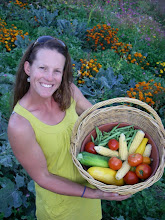Area farm growing a new trend
By Lily Raff / The Bulletin
Sarahlee Lawrence
If I told you this column is about a Central Oregonian's first-ever farming season, you'd probably expect a sob story with dreams of a High Desert bounty crushed between a cold, late spring and an early autumn frost.
Spoiler alert: It's not.
Make no mistake, this is a success story, despite this summer's, well, challenging weather.
The farmer is Sarah- lee Lawrence, a 27-year-old who grew up on her parents' ranch near Terrebonne, left to study environmental science in college and graduate school, then worked as a river rafting guide for several years. She was teaching a course at the Wild Rockies Field Institute, in Colorado, when she came across some alarming curriculum materials about food. She learned, for example, that our food travels an average of 1,500 miles from the field to our plates.
“I just didn't realize that all these environmental issues existed with food,” she says. “I didn't realize that food is the biggest (part of our) carbon footprint and our biggest use of petroleum.”
Then she thought: “I could do something about that.”
Two years ago, she went home and planted cover crops to restore nutrients to the land where her parents had grown conventional hay. She shoveled 200 tons of manure onto the property to transform a three-acre patch of thin, volcanic soil into rich humus capable of prodducing vegetables.
Onlookers raised their eyebrows skeptically. Did she forget how cold it gets at night? There are other places where growing seasons are long and mild.
But Lawrence's reasoning was simple. “Why do we need to grow food here? Because we live here,” she says.
“Besides, it's not like we're tackling something impossible,” she adds. “It just takes more time and money than in some other places.”
She plowed ahead, naming her farm Rainshadow Organics, and turning to other farmers in Central Oregon for mentorship.
“They're skilled and super dedicated,” she says of local organic food growers, “and maybe a little crazy.”
Then she joined them. In early spring, she started seeds in the greenhouse.
She found an experienced helper, Michael Adcock, through a program called Willing Workers on Organic Farms.
In May, they began transplanting the sprouts into a one-acre plot they call the “baby garden,” where well water and a warm microclimate allow them to pamper delicate plants.
Meanwhile, word of her farm spread, especially in Sisters, which didn't have as many Community Supported Agriculture options as Bend and Redmond.
“People have been so, so enthusiastic,” she says. “I thought people would be supportive, but this ... blew me away.”
By late June, nearly 40 families had joined the CSA. They paid a flat fee at the start of the season in exchange for a weekly box of whatever produce she could provide. Lawrence is optimistic she'll find 60 members next year.
She also struck deals with St. Charles Redmond and several restaurants in Bend. Farmers markets, on the other hand, turned out to be an inefficient way to sell her goods.
All summer, to Lawrence's delight, food kept popping out of the ground.
“Everybody says, ‘You can't grow anything in Central Oregon.' Well, it turns out you can grow a lot,” she says.
From exotic-sounding green zebra tomatoes (in the greenhouse) and dragon-tongue beans to common spinach and onions, the farm did, in fact, produce a bounty, albeit for two short months.
Lawrence is getting close to winning the equivalent of the local farmers' lottery. She's in talks with St. Charles Bend to provide more produce to the hospital system next year, which could mean expanding by as many as 50 acres.
In other words, Lawrence isn't giving up her farming dream anytime soon.
“I love my job,” she says. “I hope I can do this until I'm, like, 100.”

No comments:
Post a Comment